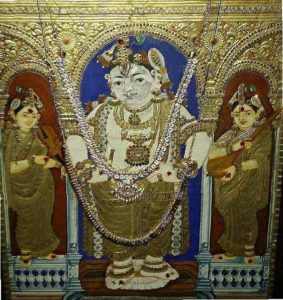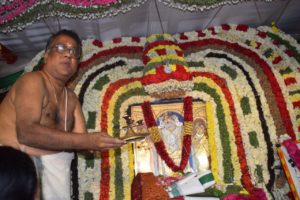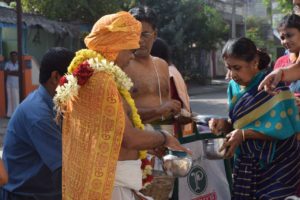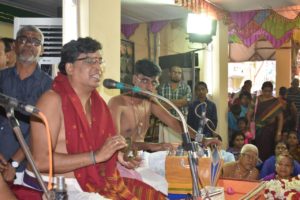Sri Radha Kalyana Mahotsavam
Radha Kalyanam: Meaning and Method
Sri Radha Kalyana Mahotsavam follows the path of namasankeerthanam to help practitioners attain moksha (immortality or liberation from birth and death cycles). Namasankeerthanam is the highest form of devotion in Kaliyugam (for a related interesting story click here). The namasankeerthanam follows the structured form of Dakshina Bharatha Sampradaya bhajan (south Indian religious system of singing devotional songs). As the name suggests, it is an orderly collection of renditions followed in Radha Kalyanam, especially in south India. An important component of this structured bhajan is the singing of Jeyadevar’s Geetha Govindam. Many of us wonder why we, ordinary mortals, conduct the divine union of gods. Radha Kalyanam is a way of presenting the most potent concept of Advaita philosophy to the common man for the benefit of whole humanity. According to the great saint Adi Shankara, who propounded the Advaita, jeevatma is nothing but a creation of Paramatma and is destined to reunite with Paramatma. Radha Kalyana Mahotsavam helps this Supreme Truth of reunion of jeevatma with Paramatma reach people of all walks of life.
The Origins and History of MRK
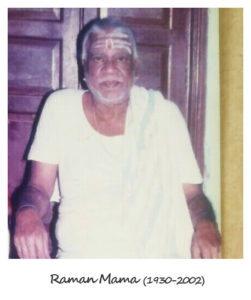 The origin of the Mayuram Radha Kalyanam (MRK) with Annadhanam has an interesting mystical trace. Mayiladuthurai is a town in Nagapattinam district, Tamil Nadu, India located on the banks of river Kaveri (Cauvery). Since ancient times, this town has been in the heart of culturally and economically rich activities. Mayuram, as it is popularly known, has been hosting many religious annual and seasonal festivals. One such festival, Sri Thyagaraja Aradhana, has been taking place through the 1940s and early 50s with the profound efforts of an ardent devotee of Lord Pandurangan (Vittal), Shri. Lakshmana Iyer every year at the Senthangudi Japa Matam (a hall for chanting or meditation) located on the northern banks of the river Kaveri, very close to Thula Kattam. This matam (mutt) had played a major role in the birth of MRK. The mutt is abutted by a peepal tree and a temple of Lord Ganapathy named Mangala Vinayakar temple. A portrait of Lord Radhakrishna with His consorts Sathyabama and Rukmini adorns the mutt though no puja or food was offered then.
The origin of the Mayuram Radha Kalyanam (MRK) with Annadhanam has an interesting mystical trace. Mayiladuthurai is a town in Nagapattinam district, Tamil Nadu, India located on the banks of river Kaveri (Cauvery). Since ancient times, this town has been in the heart of culturally and economically rich activities. Mayuram, as it is popularly known, has been hosting many religious annual and seasonal festivals. One such festival, Sri Thyagaraja Aradhana, has been taking place through the 1940s and early 50s with the profound efforts of an ardent devotee of Lord Pandurangan (Vittal), Shri. Lakshmana Iyer every year at the Senthangudi Japa Matam (a hall for chanting or meditation) located on the northern banks of the river Kaveri, very close to Thula Kattam. This matam (mutt) had played a major role in the birth of MRK. The mutt is abutted by a peepal tree and a temple of Lord Ganapathy named Mangala Vinayakar temple. A portrait of Lord Radhakrishna with His consorts Sathyabama and Rukmini adorns the mutt though no puja or food was offered then.
Of the many devotees who attended the Aradhana at the mutt, Shri. B. Ramakrishna Iyer, another fervent follower of Lord Vittal, of North Ramalinga Agraharam, worked shoulder to shoulder with Lakshmana Iyer in conducting the annual Aradhana fest. It seemed like Lord Vittal planned more for Raman mama (as Iyer is fondly called). In a fortuitous night, by the end of 1954, Lord Radhakrishna appeared in Raman mama’s dream and asked why daily puja was not being performed for Him (the Lord) at the mutt and why was He (the Lord) made to starve altogether. Mama awoke with a start and a divine spark of enlightenment was ignited in him. Immediately at break of the day, he arranged daily puja with cooked rice as food offering for Lord Radhakrishna, which has been carried on to date.
In the meantime, the ignited divine spark grew into a flame in Iyer’s heart. He wished to spread the name of Lord Radhakrishna all around him. To effect this wish, in 1955 he joined hands with two of his like-minded friends, Shri Ramasesha Iyer alias Dasu mama and Shri Ayyasamy alias Ayyan mama, to organize the first Mayuram Radha Kalyana Mahotsavam with Annadhanam at the same venue as of the Aradhana, Senthangudi Japa Matam (it has a seating capacity of 60, from which we can get an idea of the humble beginnings of the MRK) with few hundred rupees contributed by the people living in the streets around the Japa Matam.
At first, Raman mama and Dasu mama used to visit surrounding villages, such as Mudikondan, Anathandavapuram, Arayapuram, Siddhamali, Keeranur, and Senthangudi, to propagate the idea of namasankeerthanam via Radha Kalyanam and invited devotees to attend the MRK. Though the function was performed on a small scale utilizing the donations collected in those villages and in Mayuram town, the religious fervor was no less intense. This was the prime reason for the growing popularity of the MRK. The bhajans were predominantly rendered by leading bhagavathars (singers of God’s glory) of the day, Thegattur Naganatha Bagavathar, Thiruvaiyaru Nagaraja Bagavathar and mridangam (a percussion instrument) exponent Ramakrishna Iyer.
Lead Bhagavathars
In the early years, Srivanchiyam Ramachandra Bhagavathar and Mayuram Krishnamurthy Bhagavathar were the lead singers of the MRK. After their initial stint, the stage was taken over by Thegattur Naganatha Bhagavathar and his group until 1972. Here again, Lord Vittal played out his wish to make the Mahotsavam grander. He gave another interesting twist to the function.
In 1972 when Ramakrishna Iyer went to attend the Radha Kalyanam taking place in Vanagiri village near Tiruvengadu, Srivanchiyam Ramachandra Bhagavathar, who was leading the function, expressed his willingness to participate in MRK once again in his own style. He, appearing in a fortune-teller role during Kuravan Kurathi dance (one of the interludes performed in abhinaya alankara divyanam bhajan), asked Ramakrishna Iyer, “Why you are not calling me for your function?” Iyer later assured him that his desire would be fulfilled. Soon it seemed that it was not Iyer who gave that assurance but Lord Krishna himself.
In the very next year, 1973, that is, the 18 th edition of MRK, it so happened that Thegattur Naganatha Bagavathar who had been performing Radha Kalyanam all along fell ill and was unable to take part. Hence, the torch was handed over to Srivanchiyam group that comprised E.K. Srinivasa Bhagavathar, E.K. Jeyarama Bhagavathar, N.S. Venkatarama Bhagavathar (NSV), and Thiruvaiyaru Venkatarama Bhagavathar. With this change of baton, the popularity of Mayuram Radha Kalyanam soared, mainly due to the expansion of divyanama bhajan to Abhinaya Alankara Divyanama Bhajan, introducing interesting interludes from Baktha Vijayam presented by the group re-enacting the lives of famous Hindu saints, such as Meerabhai, Purandara das, Kabirdas, Thiruneelakandar, Gora Kumbhar, Pundareekan and Baktha Ramadas.
The year 1980 which marked silver jubilee celebrations brought with it quite a few novelties. The event was extended from the usual three days to a week. The venue was shifted from the Senthangudi Japa Matam to the more spacious present venue, Thula Ghat Vallalar koil Mandapam, owned by Dharmapuram Adeenam (a Saivite mutt). Though the proposed budget exceeded tenfold of previous years’, Raman mama firmly believed that Lord Vittal will take care of it and eventually mama’s faith proved true. Annadhanam has been extended to all days of the event from that year onwards. One more novelty introduced by mama was the Carnatic classical music concerts by popular artists as part of the celebrations (for more on concerts click here).
Highlights of the debut year programs included renowned singers Radha Jayalakshmi sisters’ endearing vocal concert and Pulavar Keeran’s crisp religious discourse. That year also saw the debut of the famous duo of Thiruvengimalai Ramji and Gopu’s (as an interlude during Abhinaya Alankara Divyanama Bhajan) in the MRK; their maiden enactment of kudukuduppai (soothsaying) was a great hit. Overwhelmed by the size and patronage of the crowd that turned up for the occasion, as well as the huge funds that poured in as donations from the public, Ramakrishna Iyer decided to include two concerts by popular Carnatic musicians as a regular fixture on Friday and Sunday evenings. Abhinaya Alankara Divayana Bhajan continued to sizzle the devotees on Saturday evening. One more specialty of that year’s celebration was the enthusiastic and tremendous efforts of younger generation of the surrounding streets, fondly known as Kaveri Karai Friends, in huge numbers which enabled Raman mama and organizers to take a giant leap to the next level and the joyous trend continues unabated to the present day. Last highlight but not least was the large donations given by the Muslim community.
After the time of two of the founder-members, Dasu mama and Ayyan mama, the youth of the surrounding streets and students of the nearby schools actively shared the responsibility of helping Raman mama. A special mention is deserved for Shri.K.Santhanam of Arayapuram here for his role. Meanwhile, the Herculean task of heading the MRK stage had been carried on by Srivanchiyam Ramachandra Bhagavathar, from 18th to 46th year (1973–2001). With his declining health, he could not participate in the event full-fledged. By then, Lord Vittal had already readied his successor in Dr. Udayalur Kalyanarama Bhagavathar (UKB). Way back in 1988, our beloved Udaiyalur Kalyanarama Bhagavathar joined Srivanchiyam on the stage. It was Babu Rajasekaran, a local lad and the miruthangist to Dr. UKB, who brought him to the stage, inseparably entwining him to the MRK. With the passing away of the legendary Srivanchiyam Ramachandra Bhagavathar in 2003, Kalyanarama Bhagavathar took the responsibility of heading the Sampradaya Bhajan Paddhati of MRK on his shoulders under the artful guidance of the senior most of the Srivanchiyam troupe, Shri E.K. Srinivasa Bhagavathar (EKS) and E.K. Jayarama Bhagavathar (EKJ). A number of eminent local and Tamil Nadu-wide bhagavathars, such as Pichumani Bhagavathar, Kovai Jayarama Bhagavathar, Udayalur Balrama Bhagavathar, Mayuram Vijayan Bhagavathar, Jaitheertha Bhagavathar, Bruha Balu Bhagavathar, Gyanaguru Bhagavathar, Muthukrishna Bhagavathar, Narasimha Bhagavathar, senior miruthangists Poompuhar Babu Rajasekaran, Rajesh and Sivakumar, Dolki Vagula varnam, harmonium player Shankar Raman , among others, added grandeur to the already magnificent ensemble.
The MRK goes on post Raman mama
In 2002, exactly 10 days before 47th edition of MRK, Ramakrishna Iyer left this world to the divinely abode. In the wake of this sudden departure of Raman mama, there arose a great dilemma whether to go ahead with the planned event. After intense deliberations among organizers, ultimately it was decided to proceed with the event as planned, since everyone felt going ahead was the only means of bringing solace to the soul of Raman mama, who spread the divine light of the namasankeerthanam as per the divine wish and cherished conducting MRK all through his life. Though Iyer passed away, he has left behind six virtuous sons who all have the natural inclination and affinity towards carrying on the tradition of organizing MRK successfully with the support of their friends, relatives, and colleagues from the 47th year onwards.
Much akin to the 25th year, the 50th year celebrations were also conducted for 7 days. Devotees enjoyed 14 Carnatic concerts that were held in the space of 7 days, all by A-grade artists, such as Bombay Jayasree, T. M. Krishna, Sudha Raghunathan, Kunnakudi Vaidyanathan, Aruna Sairam, Unnikrishnan, and Nithyasree (maiden performance). What better way to celebrate than gratefully remembering those who have made the event sparkle from its earliest days to the present? All the bhagavathars who participated since the first year, the professionals who arranged mike, light, flowers, and nadhaswara vidwans and purohits (those conducted pujas) who were with the MRK for a long time were honored with a gold coin and a shawl. Those who had shorter association with the festival were also honored with gifts. By Devi Annapoorani’s abundant blessings, annadhanam could take place on all seven days without any hiccups. It was widely believed that this gala would have made Raman mama proud.
The MRK is for the people, by the people. The event has not been commercialized with sponsors. The event has been conducted solely with the contributions of the devotees residing in and around Mayuram but also those living in other states and abroad. With the advent of social media, the organizers have relentlessly been popularizing Sri Radha Kalyana Mahotsava Sampradayam far and wide across the globe. The MRK has set foot in the digital world with its own Facebook (Mayuram Radhakalayanam with Annadhanam) and Twitter (RK_Mayuram) accounts, along with a YouTube channel (Mayuram Radhakalyanam). Our website you are currently viewing is one more of our efforts to popularize namasankeerthanam and invite devotees to participate in the Mayuram Radha Kalyanam every year and get Lord Vittal’s blessing to cross the samsara (endless cycles of birth and death) to attain moksha (immortality).


